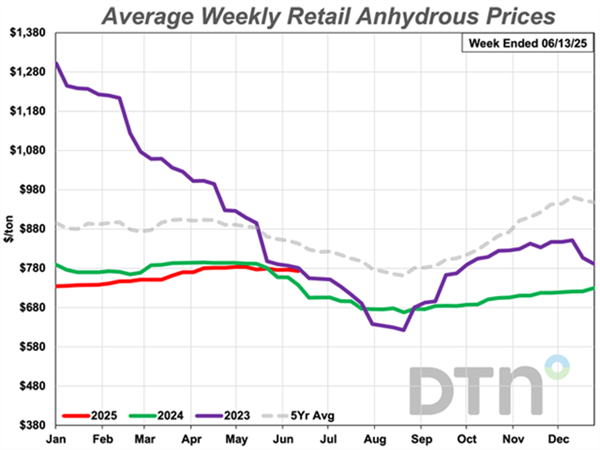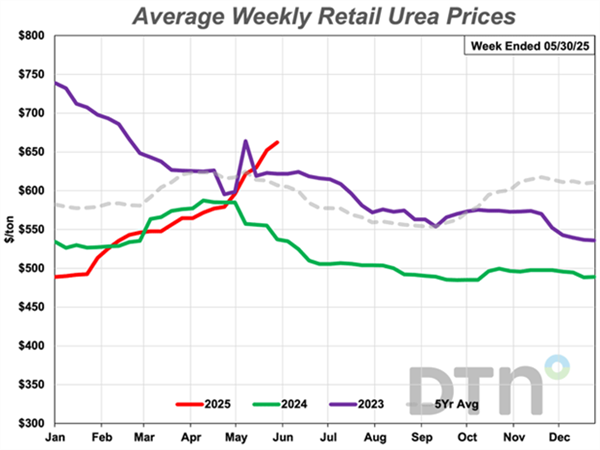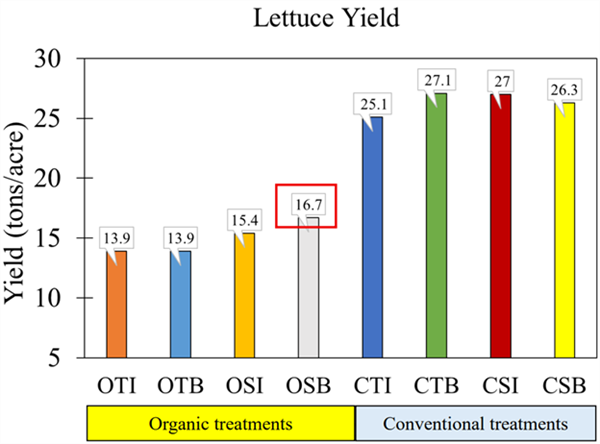
Fertilizer prices have been relatively stable in 2025 and close to 2024 prices. In the last four to six weeks fertilizer prices have been increasing. Based on recent reports, prices for seven major fertilizers are now trending higher than a year ago. Price increases compared to 2024 are shown in Table 1. Recent market prices for the same seven fertilizers are listed in Table 2.

Table 1. Percent fertilizer price increases compared to 2024. Source: Quinn, 2025b.

Table 2. Recent fertilizer prices, US$/Ton. Source: Quinn, 2025b.
Anhydrous ammonia (82% nitrogen (N)) is a common measure of the fertilizer market since most N containing fertilizers are based on anhydrous ammonia in manufacturing. Price trends for anhydrous ammonia are presented in Figure 1 comparing prices for 2023-2025 with a five-year average.

Figure 1. Average weekly retail anhydrous ammonia (82% nitrogen) prices in 2023-2025
and five-year average, US$/Ton. Source: Quinn, 2025a
One concern in the fertilizer industry currently is associated with urea (46% N), which has been steadily increasing in price over the past six months (Figure 2). These concerns have recently been exacerbated by the conflict in the Middle East that has closed urea production in Iran.

Figure 2. Average weekly retail urea fertilizer prices in 2025, US$/Ton. Source: Quinn,
2025a
In 2024, Iran was the third largest global producer of urea. Annual urea export volumes from Iran have been around 4.5 million (M)tons, which is about the same as China’s urea export production. Industry experts estimate urea production of Iran to be approximately 8.9 M tons/year. Their major international clients have included Turkey, Brazil, and Argentina. The Iranians sell urea to many other countries as well (Hanrahan, 2025).
In recent years, the United States has not been purchasing Iranian urea. But the disruption in anhydrous ammonia and urea production from a major producer such as Iran, can be expected to create disruptions in the global fertilizer market.
This happened with N fertilizers in 2022 following the Russian invasion of Ukraine, after which global N fertilizer prices rapidly increased. After about 18 months fertilizer prices stabilized (Figures 1 and 2).
With the instability and uncertainties that are currently being experienced with Middle Eastern conflicts, it is important to watch global fertilizer markets and expect some changes.
References:
Hanrahan, R. 2025.Iran-Israel Conflict Adds Uncertainty to Fertilizer Market. University ofIllinois Farm Policy News Summary, 17 June 2025. https://farmpolicynews.illinois.edu/2025/06/iran-israel-conflict-adds-uncertainty-to-fertilizer-market/
Quinn, R. 2025a. DTNRetail Fertilizer Trends: Urea, UAN28 Lead Major Fertilizer Prices Higher.Progressive Farmer, DTN. 4 June 2025.
Quinn, R. 2025b. DTNRetail Fertilizer Trends: All Retail Fertilizers See Only Slight Price Movesfor First Time This Spring. Progressive Farmer, DTN. 18 June 2025. https://www.dtnpf.com/agriculture/web/ag/crops/article/2025/06/18/retail-fertilizers-see-slight-price
Hi, I’m Chris, and I’m thrilled to be stepping into the role of extension associate for plant pathology through The University of Arizona Cooperative Extension in Yuma County. I recently earned my Ph.D. in plant pathology from Purdue University in Indiana where my research focused on soybean seedling disease caused by Fusarium and Pythium. There, I discovered and characterized some of the first genetic resources available for improving innate host resistance and genetic control to two major pathogens causing this disease in soybean across the Midwest.
I was originally born and raised in Phoenix, so coming back to Arizona and getting the chance to apply my education while helping the community I was shaped by is a dream come true. I have a passion for plant disease research, especially when it comes to exploring how plant-pathogen interactions and genetics can be used to develop practical, empirically based disease control strategies. Let’s face it, fungicide resistance continues to emerge, yesterday’s resistant varieties grow more vulnerable every season, and the battle against plant pathogens in our fields is ongoing. But I firmly believe that when the enemy evolves, so can we.
To that end I am proud to be establishing my research program in Yuma where I will remain dedicated to improving the agricultural community’s disease management options and tackling crop health challenges. I am based out of the Yuma Agricultural Center and will continue to run the plant health diagnostic clinic located there.
Please drop off or send disease samples for diagnosis to:
Yuma Plant Health Clinic
6425 W 8th Street
Yuma, AZ 85364
If you are shipping samples, please remember to include the USDA APHIS permit for moving plant samples.
You can contact me at:
Email: cdetranaltes@arizona.edu
Cell: 602-689-7328
Office: 928-782-5879
Interested in the latest developments in automated weeding machines and ag tech? There are a couple of opportunities at the upcoming 2025Southwest Ag Summit to stay up to date. One is the “Ag Tech: Innovations in Weed Control and Vegetable Crop Production Technologies” breakout session where university experts and cutting-edge innovators will provide updates on the latest advances in AI high precision smart spot sprayers and soil steaming for pest control (agenda below). The session will be held Thursday, February 20th from 1:30-3:30 pm at Arizona Western College (AWC) in Yuma, AZ.
The other is the Southwest Ag Summit Field Demo on Wednesday, February19th, where several of these technologies and other state-of-the-art automated weeders will be demonstrated operating in the field. The Field Demos will also be held at AWC. Breakfast will be served at 7:00 am and demonstrations begin at 8:00 am.
For more information about the Southwest Ag Summit, visit https://yumafreshveg.com/southwest-ag-summit/.

In the August 21, 2024 update we mentioned our plans to do a demonstrative trial at the Yuma agricultural center. This experiment was established on 10/2 and planted on 10/14. Sprinklers started on10/15. A stand evaluation was done on 10/28 and Phytotoxicity and Goosefoot and Lambs quarter weed control evaluated yesterday. The treatments suggested by some of the people in the industry, where:
Treflan (trifluralin) Applied at 1.5pt/A pre-emergent on the flat ground incorporated mechanically by disking approximately at 4” depth, then make the beds and plant the crop to germinate with sprinkler irrigation. The same method was utilized for Prowl herbicide at the rate of 1 pint product per acre. Also Prowl non-incorporated was included, Devrinol2XL at 1 pt/A, Prefar at 6qt/A as well as a high rate of Goal (oxifuorfen)preemergence to evaluate and document phytotoxicity levels.
As mentioned, we have collected weed control data, which we plan to include in future updates.
Would you like to see how this treatments look? Some of the observations, even though expected are very interesting, such as the fact that 16 floz of Goal Tender preemergence didn’t allow goosefoot germination but similarly broccoli didn’t emerge.
Come to the NW corner of the Ag Center (you can’t miss it) and look at the plots and see the difference between Prowl mechanically incorporated and non-incorporated, compare it with Prefar and Devrinol. We put some very clear signs as you can see in the picture above. The experimental plots are 14x60ft so they are large enough to illustrate what would happen in a farm.
We thank you for your suggestions ...please come and let us know what you think!

We conducted a series of trials during Fall 2024 and Spring 2025 to evaluate the efficacy of organic-approved insecticides currently on the market. While some of the products evaluated were found to be effective, the results of our studies demonstrated that most of these marketed organic-approved insecticides had marginal to no efficacy against common insect pests that attack vegetable crops in the desert. When the insecticides were evaluated alone, the highest label rate was used; when assessed as a mixture of two products, each product was applied at half of the label rate.
Below, we list the insecticides that resulted in some level of suppression for each insect pest.
1- Brassica
Pale stripes flea beetle: Biolink (insect & bird repellent), Insect & Bird repellent mix with Pyganic, and Entrust mix with M-Pede can provide measurable suppression of pale stripe flea beetle. Multiple applications may be required to enhance seedling protection.
Whitefly: M-Pede performed best against whiteflies on brassicas, but Surround, Pyganic, and BotaniGard can also provide some marginal level of suppression. It is best to apply Surround and BotaniGard when the plants are small. Dense foliage prevents insecticide droplets from reaching the lower leaves, where most whiteflies are located on the plants.
Diamondback moth and Beet armyworms: XenTari, DiPel, Entrust, a tank mix of DiPel and Pyganic, or XenTari and Pyganic are the most effective options for controlling diamondback moth and beet armyworms. Starting with XenTari in a rotation program can lead to greater suppression of diamondback moths.
Green peach aphid: Aza-Direct can provide measurable (greater than 50% reduction) green peach aphid suppression on broccoli. Because Aza-Direct works as a growth regulator, it is recommended to apply it early in the season to allow the product sufficient time to work and enhance its efficacy.
2- Lettuce
Green peach aphid: Aza-Direct and M-Pede exhibited variable performance when applied to broccoli or lettuce. Aza-Direct performed better at controlling green peach aphid in broccoli, but M-Pede provided the greatest (>50% suppression) green peach aphid suppression in lettuce.
Thrips: Entrust can provide excellent (>90%) control of thrips nymphs and adults. In our studies, other bioinsecticides, such as Gargoil and Aza-Direct, also resulted in thrips suppression of approximately 40% and 50%, respectively. In a rotation program, Aza-Direct and/or Gargoil can be applied at the beginning of the season when thrips populations are low, and thrips injuries are less problematic.
Bioinsecticides and their active ingredients

Improving crop yields through sustainable practices remains a key goal for agricultural research, particularly in regions facing environmental constraints like desert conditions. Biostimulants, products known to enhance plant growth, nutrient uptake, and resilience against environmental stress, offer potential benefits for organic agriculture, especially when integrated with precision irrigation techniques. This study, conducted at the Yuma Agricultural Center (University of Arizona) during the Fall 2024–Spring 2025 growing seasons, evaluated the effects of biostimulant combined with sensor-based irrigation scheduling on iceberg lettuce production under organic and conventional systems. The experimental design included four treatments each for organic and conventional systems, which combined traditional irrigation, sensor-based irrigation, and biostimulant applications.
Results indicated clear distinctions between organic and conventional lettuce systems in response to biostimulant treatments. In organic fields, the integration of biostimulant with sensor-based irrigation (OSB) achieved the highest yield, approximately 16.7 tons per acre. This represented a 20% improvement over organic treatments without sensor-based scheduling (OTI and OTB, 13.9 tons per acre) and an 8.4% increase over sensor-based irrigation without biostimulant (OSI, 15.4 tons per acre). These yield differences highlight the synergistic effect of combining biostimulant with precise irrigation water management techniques in an organic lettuce production system, potentially due to enhanced soil nutrient availability, improved root growth, and optimized water uptake. Conversely, conventional treatments yielded consistently high production across all variations, averaging around 27 tons per acre, with no measurable yield enhancement from adding biostimulant. This may indicate that conventional systems already operating at optimal nutrient and irrigation levels have limited potential for further yield improvement through biostimulant use.
These findings emphasize that biostimulant suggestively enhanced yield in organic lettuce production only when combined with sensor-based irrigation management but offered negligible benefits under conventional farming conditions. The outcomes suggest potential economic and environmental benefits for organic producers adopting integrated management practices involving biostimulant and sensor-based irrigation. Figure 1 provides detailed comparisons of yields across treatments, emphasizing the advantage of coupling biostimulant with sensor-based irrigation in organic systems at the Yuma Agricultural Center.

Figure 1. Lettuce yield: Organic Field: Organic sensor-based irrigation + biostimulant
(OSB), Organic traditional-based irrigation (OTI), Organic traditional-based irrigation +
biostimulant (OTB), and Organic sensor-based irrigation (OSI); Conventional Field:
Conventional sensor based irrigation + biostimulant (CSB), Conventional traditional-based
irrigation (CTI), Conventional traditional-based irrigation + biostimulant (CTB), and
Conventional sensor-based irrigation (CSI) at the Valley Research Center, University of
Arizona, Yuma Agricultural Center, Yuma, Arizona.
This time of year, John would often highlight Lepidopteran pests in the field and remind us of the importance of rotating insecticide modes of action. With worm pressure present in local crops, it’s a good time to revisit resistance management practices and ensure we’re protecting the effectiveness of these tools for seasons to come. For detailed guidelines, see Insecticide Resistance Management for Beet Armyworm, Cabbage Looper, and Diamondback Moth in Desert Produce Crops .
VegIPM Update Vol. 16, Num. 20
Oct. 1, 2025
Results of pheromone and sticky trap catches below!!
Corn earworm: CEW moth counts declined across all traps from last collection; average for this time of year.
Beet armyworm: BAW moth increased over the last two weeks; below average for this early produce season.
Cabbage looper: Cabbage looper counts increased in the last two collections; below average for mid-late September.
Diamondback moth: a few DBM moths were caught in the traps; consistent with previous years.
Whitefly: Adult movement decreased in most locations over the last two weeks, about average for this time of year.
Thrips: Thrips adult activity increased over the last two collections, typical for late September.
Aphids: Aphid movement absent so far; anticipate activity to pick up when winds begin blowing from N-NW.
Leafminers: Adult activity increased over the last two weeks, about average for this time of year.







